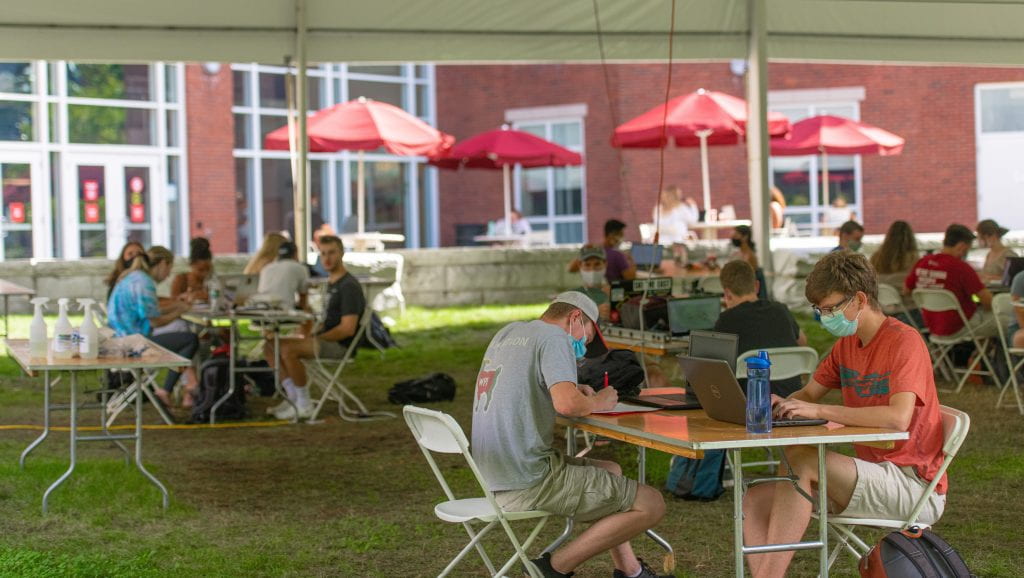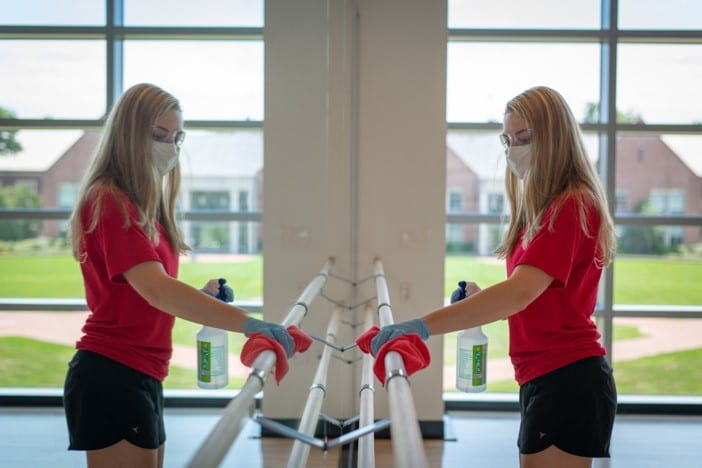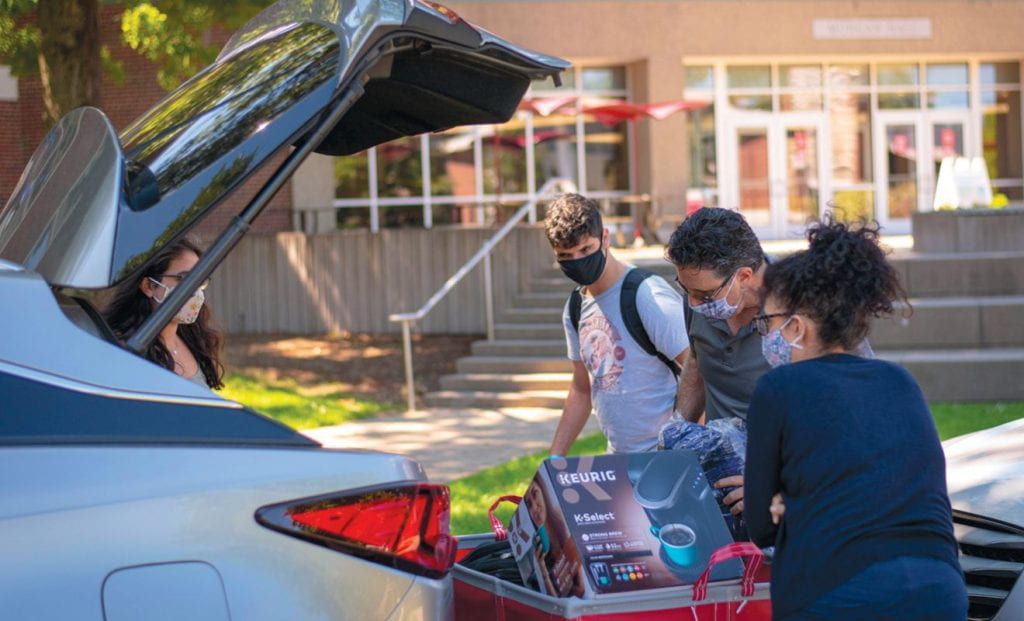Health on the Line
How WPI built a health infrastructure to help manage a global pandemic.
Read StoryWhen WPI decided to repopulate the campus in the fall of 2020 in the midst of a pandemic, there were a million details to attend to and no blueprint to follow
The very idea of college brings to mind campuses bustling with active students spending time together in their residence hall rooms and lounges, outdoors on green quadrangles, and side-by-side in crowded dining halls. Images like these form the visual backdrop of every college movie, and have made up the memories of alumni for generations.
WPI students were asked to leave campus at the start of the pandemic, and classes were offered remotely for the balance of the spring and the summer terms. Most undergraduates were home on break when the residence halls were closed, necessitating a carefully choreographed process later that spring to allow students to return to campus briefly to retrieve their belongings. The complexity of that move-out would be dwarfed by what was to come, for on July 1, 2020, the announcement went out that students would return in time for the start of A-Term and the fall semester.
The task of determining how to do that safely fell to the Coronavirus Emergency Response Team (CERT). Within CERT, a team led by Emily Perlow, associate dean of students, and Casey Wall, assistant dean and director of residential services, focused on the student life experience. It was a job that no one at WPI had ever attempted before, one that would include repopulating residence halls while maintaining social distancing (the term “de-densified” entered everyone’s vocabulary that summer). It also included helping students manage the stress of uncertainty and isolation during a global health crisis. Somehow it happened, marking one of the most significant success stories of WPI’s responses to the pandemic.

When it was announced that students would be back on campus, with the university offering them three options for taking classes—in-person, remote, and a hybrid—Perlow said the first step was visualizing a new campus environment with coronavirus precautions in place.
“Casey and I began considering what life would look like outside the classrooms,” she says. “Could students live together? Could we test them for COVID, and how often? How could you convince students to comply with mask mandates and social distancing requirements? We spent a lot of time trying to predict student behavior. That was probably 60 percent of our day.”
Systems had to be put in place that would strive to serve all students and keep them safe, yet give them a customizable experience based on their level of comfort. “That summer we were working seven days a week,” Wall says, planning students’ return in collaboration with their partners on CERT.
“They put their heads down and did a ton of incredible work to bring us back to campus,” says Ryan Candy ’21, a community advisor who helped 20 first-year students get acclimated to WPI over the summer.

Starting in July 2020, each student planning to live and study on campus in A-Term/fall semester filled out a form that spelled out their preferences for housing and classes; students could choose to be on campus, remain remote, or pursue a hybrid version. Students’ intentions and WPI’s responses would undergo modifications as the summer progressed and the plans for housing and classes evolved. The goal was to meet students’ expectations as closely as possible, within the limitations imposed by the pandemic. “It may have made more work for us in the background,” Wall says, “but we were constantly advocating for what was best for the students.”
“At WPI, we have always relied on the orientation and welcome process to help socialize students to the ‘ways of WPI’ and to build community,” Perlow says. “With the pandemic, we couldn’t rely on our typical mechanisms.”
So they found themselves creating new systems for once well-oiled routines like residence hall move-in, always with guidance from CERT, which was, itself, evolving as the effects of the pandemic changed. “We had no idea if the plans we put in place were going to work,” she says. “We were asking ourselves, ‘If we mess this up—if we can’t keep COVID from spreading on campus—what will the impact on the institution be?’”
“It was a lot to think about, and we weren’t the only ones in that position,” Wall says.
As part of the reopening plans, CERT established a color-coded guide to campus life based on the current rate of positive COVID-19 tests. The scale ranged from Red/Severely Limited, with fully remote operations, to Green/TechFlex On-Campus, with in-person, hybrid, and remote learning, de-densified residence halls and classrooms, and open research labs.
It may have made more work for us in the background, but we were constantly advocating for what was best for the students.
Casey Wall, Assistant Dean and Director of Residential Services
A-Term began with the campus in the TechFlex state. The fall and winter saw periods of rising infection rates, nationally and locally, which triggered the Yellow/Stay in Place alert level, with virtually all classes offered remotely and most students required to stay in their residence hall rooms with limited exceptions (for example, to pick up food, seek medical care, get a COVID-19 test, or engage in socially distanced exercise). It was never necessary to invoke the Orange or Red alert levels, which called for sending students home once again.

Concern about students’ mental health grew during the Yellow alert periods. Wall and Perlow note that the usual ways of checking up on students who might need help were not possible. It wasn’t feasible to send resident advisors (RAs) to their rooms or invite students to lunch. “We couldn’t rely on those things we’d normally do,” Perlow says. “That was really hard, especially in supporting first-year students. We were missing those first-year connection points last year. RA check-ins were harder to do. There were fewer in-person club activities. There was no going out to eat.”
“Normally, you can do homework together,” Candy says. “That’s difficult to do in ‘COVID world.’ There weren’t parties. You couldn’t be in a residence hall unless you lived there. We kept comparing it to the loss of water-cooler conversations: on Zoom, you can send private messages, but it’s not the same. It was tough.”
The Department of Physical Education, Recreation and Athletics (PERA) was tasked with trying to provide healthy and safe sport and fitness activities for the WPI community within explicit state COVID guidelines for gyms and recreational facilities. In the spring of 2020, working with Health Services and CERT to ensure that the WPI community stayed safe, PERA set about the daunting task of providing engaging health and wellness activities when it was not yet known how the virus was transmitted (contact? surfaces? breath?).

“This past year was one of the most challenging for my group as we had to navigate what we wanted to do versus what we could do to keep our community safe in the areas of sport and recreation” says PERA director Dana Harmon. “The Health Services team were amazing partners, and my entire team put in extraordinary efforts for classes, sports, fitness, and recreation. It took a village to figure out this great unknown together.”
Within a week of the university’s shutting down in the spring of 2020, PERA developed online PE course offerings for D-Term so students could continue to fill their PE requirements for graduation. Spring sports were cancelled along with several winter sport championships, and students who’d traveled to NCAA championships had to come home immediately.
“Having those winter NCAA championships cancelled on the brink of participation, along with the spring season for club and varsity sports, was devastating,” Harmon says. “We had to pick up the pieces and continue to provide meaningful engagement to help all of our groups support each other during those early days as COVID was changing all of our lives.”

When the campus reopened in the fall of 2020, the Sports and Recreation Center reopened for students under tight COVID-19 protocols and with enhanced cleaning routines. Community members using the facility had to be in the campus testing program, they had to make reservations, and they had to wear masks and maintain social distancing. Fall and winter sports competitions were cancelled, but teams were able to participate in strength and conditioning activities and skills workouts.
We had to pick up the pieces and continue to provide meaningful engagement to help all of our groups support each other during those early days as COVID was changing all of our lives.
Dana Harmon, Director of Physical Education and Athletics
“Although losing fall and winter competitions was extremely difficult,” Harmon says, “I was impressed with and grateful to our student-athletes, coaches, and PERA staff, who all showed great resilience in carrying on to the best of their abilities so that we could continue with our sports in still meaningful ways without competition.”
A brightening picture in the spring of 2021 brought increased hours and offerings in the Sports and Recreation Center, sport activities, and in-person PE courses (with continued COVID-19 guidelines). Student-athletes and coaches welcomed the return of limited varsity sports competition in baseball, softball, men’s and women’s track and field, and men’s and women’s rowing, along with expanded practice opportunities for all of the other sports. Student-athletes were tested twice a week; two negative test results for all team members and coaches were a requirement for competition.
“Our coaches and student-athletes showed a great deal of determination in keeping themselves healthy on a daily basis as they did not want to be the individual that kept their team from competing,” Harmon says. “Their commitment and discipline were amazing. Although none of us wants to go through anything like this again, we learned a great deal about ourselves as individuals and as a group, having to turn lemons into lemonade. We are and will continue to be stronger for this experience now and into the future.”

One annual ritual of student life, the fall residence hall move-in and orientation kick-off, had to be completely rethought. In pre-pandemic days, Move-In Day was a frenetic, joyous swirl of activity as lines of cars loaded with clothes, computers, microwaves, and other necessities of residential life waited for their turn to pull up in front of their students’ new home away from home, where teams from Greek life, student athletes, and other volunteers waited to grab those belonging and whisk them away to the students’ rooms. It was a carefully planned and executed welcome to new students that conveyed the unmistakable message that this was a community that cared about them.
But nearly everything about that tried-and-true process went against the health and safety rules imposed by the COVID-19 pandemic. What would the all-new move-in look like? To begin with, students needed to be tested before they could even set foot on campus. Then, their arrival had to be staggered; in fact, the traditional move-in day morphed into a nine-day event, with students scheduled to arrive at intervals over a 12-hour period each day. A series of checkpoints along the arrival routes helped keep the process orderly, socially distanced, and safe.
While that laborious system might not continue once the pandemic officially ends, other COVID processes may be retained even after social distancing is no longer necessary. For example, to minimize human contact, students simply left their residence hall keys in their rooms when they moved out, instead of taking them to a central collection point. More convenient for students, the new procedure also yielded a higher rate of key returns, Wall says.
I think our WPI culture of peer-to-peer relationships was a secret to our success.
Emily Perlow, Associate Dean of Students
Changes made to the campus to encourage students to head outdoors to get some fresh air may also endure. For example, Adirondack chairs placed here and there proved popular for people-watching, as well as for reading and doing homework. Candy says Perlow came up with the idea of placing portable whiteboards by outdoor tables to encourage students to gather for academic work and informal chats while still staying six feet apart. Some students found creative ways to break the ice and get to know new people by posting topics on the whiteboards and inviting passersby to stop and join a conversation, making up for the hurdles the pandemic placed in the way of socializing.

Efforts to break through the isolation and build a sense of community on campus also helped with another goal: encouraging students to take seriously their role in keeping themselves and others around them safe and healthy. Perlow and Wall say they were pleased to see that WPI students were wearing masks and holding one another accountable. They were partners in the effort to create a safe campus amid COVID.
“I think our WPI culture of peer-to-peer relationships was a secret to our success,” Perlow says. “Students were saying to one another, ‘I want to be here and I will ask you, as my peer, to follow safe practices.’ Now, that is pretty powerful.”

How WPI built a health infrastructure to help manage a global pandemic.
Read Story